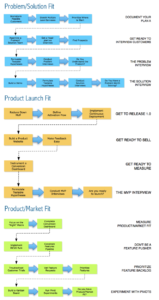The “Running Lean” process, created by Ash Maurya, is a systematic process for quickly vetting product ideas and raising the odds of success. Ash outlines the process as follows:
Process Flow
Step 1: Problem / Solution Fit
Summary
The first step is determining if this product is something worth doing. You do this by decoupling the problem from the solution and testing each through customer interviews.
Next, you will derive the minimum feature set to addresses the right set of problems – the Minimum Viable Product (MVP).
Goal
- Do I have a problem worth solving?
How
- Document your plan A – sketch lean canvas and prioritize where to start
- Get ready to interview prospects – find prospects
- Conduct problem interviews – formulate testable hypotheses, conduct problem interviews, do you understand the problem?
- Conduct solution interviews – formulate testable hypotheses, conduct solution interviews, do you have a problem worth solving?
Problem / Solution Meta Pattern
- Understand the Problem
- Conduct problem interviews
- Determine if you have a problem worth solving
- Understand how customers solve this problem today
- Validate Demo
- Solution Interview: Test your possible solution qualitatively with customers using a demo that helps them visualize the solution
- Validate Solution Qualitatively
- MVP Interview: distill down your product to it’s essence (MVP) which you then build and test qualitatively with customers
- Validate Solution Quantitatively
- Verify results of qualitative interviews with actionable macro metrics
Exit Criteria
- Is it something customers want? (must-have)
- Can it be solved? (feasible)
- Will they pay for it? If not, who will? (viable)
Step 2: Product / Launch Fit
Summary
You definitely understand your customers’ needs better than just a few weeks ago, don’t rush into building and launching your MVP just yet. It is fairly easy to get distracted during this stage and either build too much or build the wrong product. You not only need to distill down your MVP to it’s essence but also lay the groundwork to maximize your future iterations for speed, learning, and focus.
Goal
- Are you ready to learn from customers?
How
- Get to release 1.0 – scale down MVP, define activation flow, and implement continuous deployment
- Get ready to sell – build a product website and make feedback easy
- Get ready to measure – instrument a conversion dashboard
- The MVP Interview – conduct interviews, are you ready to launch?
Exit Criteria
- Be able to clearly articulate your UVP
- Be primed to sign-up for your service
- Accept your pricing model
- Make it through your activation flow
- Know what to do next
Step 3: Product / Market Fit
Summary
At this stage you have a plan that is starting to work – you are signing up customers, retaining them, and getting paid.
This is the stage when you truly start validating your complete product. While learning from customers is key, you have to know how to prioritize and then act on that learning.
The first step is defining a metric to measure Product/Market Fit. Once you have that, you can then systematically iterate towards achieving it
Goal
- Have I built something people want?
How
- Measure product / market fit – focus on the “right” macro and complete conversion dashboard
- Constrain features – constrain feature pipeline and implement 80/20 rule
- Prioritize feature backlog – vet feature requests and prioritize features
- Experiment with pivots – run pivot experiments, do you have product / market fit?
Exit Criteria
- Retain 40% of your users
- Pass Sean Ellis Test – over 40% of your users say that they would be “very disappointed” without your product
- Get paid
Sean Ellis Test
How would you feel if you could no longer use [product]?
- Very disappointed
- Somewhat disappointed
- Not disappointed (it isn’t really that useful)
- N/A – I no longer use [product]
Stage 4: How do I accelerate growth?
Goal
Your focus then shifts towards accelerating your plan for scale.
